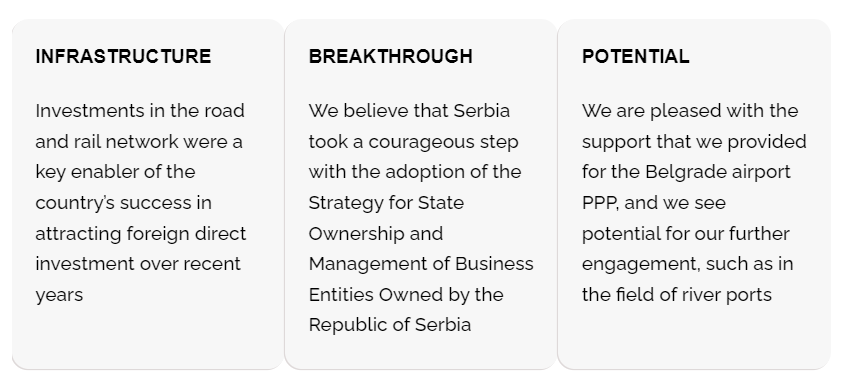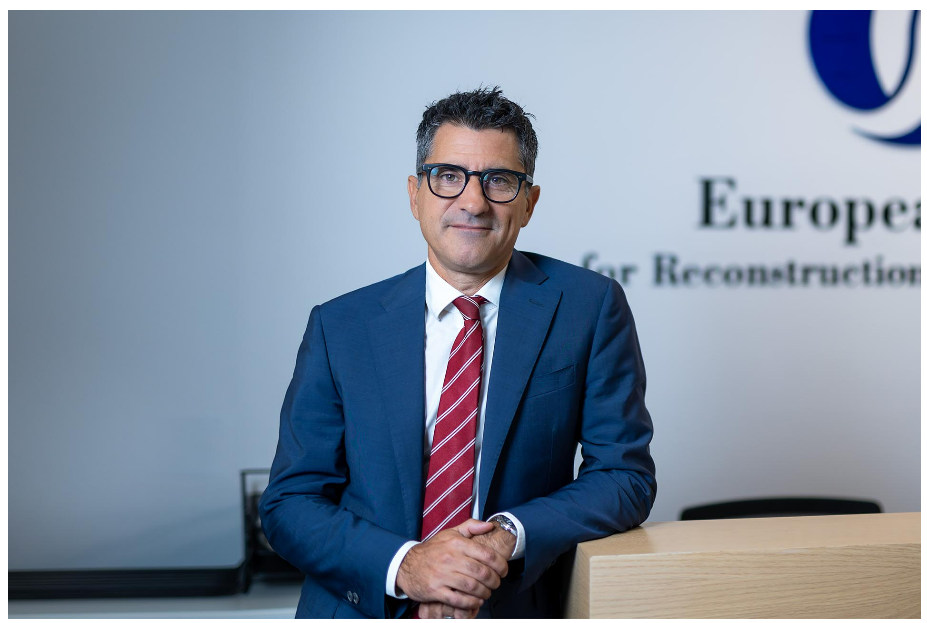MATTEO COLANGELI, FIC Board of Directors Member & EBRD Director for the Western Balkans
Achieving EU Income Levels Is Possible
The EBRD expects Serbia’s GDP to increase by around two per cent this year and 3.5 per cent in 2024. A much faster growth rate of around six per cent would be needed in order to achieve convergence with EU income levels within two to three decades, which is an ambition that this region should have.
Achieving growth rates of six per cent or more in Serbia is not out of reach, but would require a substantial pick up in productivity, particularly through the boosting of private sector investment in innovation and digitalisation – says Matteo Colangeli, EBRD Director for Western Balkans.
“We see a substantial upside in unlocking the growth potential of Serbia’s SMEs, helping them to integrate into global value chains and capitalise on the opportunities brought by foreign direct investment. Continuing to reform state-owned enterprises could also contribute to accelerating growth, leading to the more efficient provision of public services and freeing up resources to accelerate Serbia’s public investment programme, particularly when it comes to the main European rail and road corridors,” notes Colangeli.
Finally, but importantly, he adds, the green transition is a key cross cutting theme that requires an urgent focus, particularly in view of the impact that the EU’s carbon border adjustment mechanism could have on Serbia’s competitiveness.
The beginning of this year brought positive news about foreign direct investment (FDI) inflows. However, how do you assess the potential shortage of labour for economic activities in Serbia? What are the key challenges that need to be addressed?
Indeed, FDI flows to Serbia have been strong over the past five years, at around 7-8 per cent of GDP annually. Looking ahead, it is important to attract investments in higher value-added activities that are less sensitive to labour and energy costs. We have financed a few good examples in recent years and believe that Serbia remains well placed to continue to be a success story in attracting high-quality FDI.
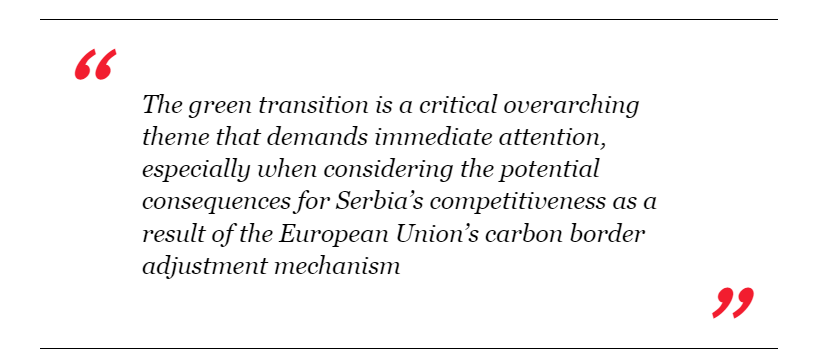 When it comes to the labour market, boosting youth and female employment would help ease the pressure on the workforce supply side, as would a systemic approach to attracting foreign workers where needed. But the ultimate goal should be to stem the brain drain and reverse the outflow of talented young Serbs from the country. A focus on creating economic opportunity is paramount for that, including beyond the Belgrade/Novi Sad area. For this, continuing to upgrade domestic transport infrastructure will be important, as will creating favourable conditions to attract investments to less developed areas of the country. However, dealing with the reasons behind emigration is a much broader topic that is ultimately linked to expectations about living standards in the country, especially when it comes to health, education and a clean environment.
When it comes to the labour market, boosting youth and female employment would help ease the pressure on the workforce supply side, as would a systemic approach to attracting foreign workers where needed. But the ultimate goal should be to stem the brain drain and reverse the outflow of talented young Serbs from the country. A focus on creating economic opportunity is paramount for that, including beyond the Belgrade/Novi Sad area. For this, continuing to upgrade domestic transport infrastructure will be important, as will creating favourable conditions to attract investments to less developed areas of the country. However, dealing with the reasons behind emigration is a much broader topic that is ultimately linked to expectations about living standards in the country, especially when it comes to health, education and a clean environment.
Recent events have prompted us to contemplate Serbia’s energy dependence and the significance of a stable energy system for business and investment activities. How would you evaluate recent developments in this sector, and what steps need to be taken to ensure sustainability and efficiency in the energy sector?
The energy crisis prompted governments to take emergency action to ensure the security and affordability of supplies. In parallel, national energy strategies and policies are developing around the transition from fossil fuels to clean energy, improved energy efficiency in industry, buildings and transport, and more energy storage. Considering that renewables have a low marginal cost, are abundant, inexhaustible and domestic, it is not surprising that they are seeing an extraordinary new phase of fast growth.
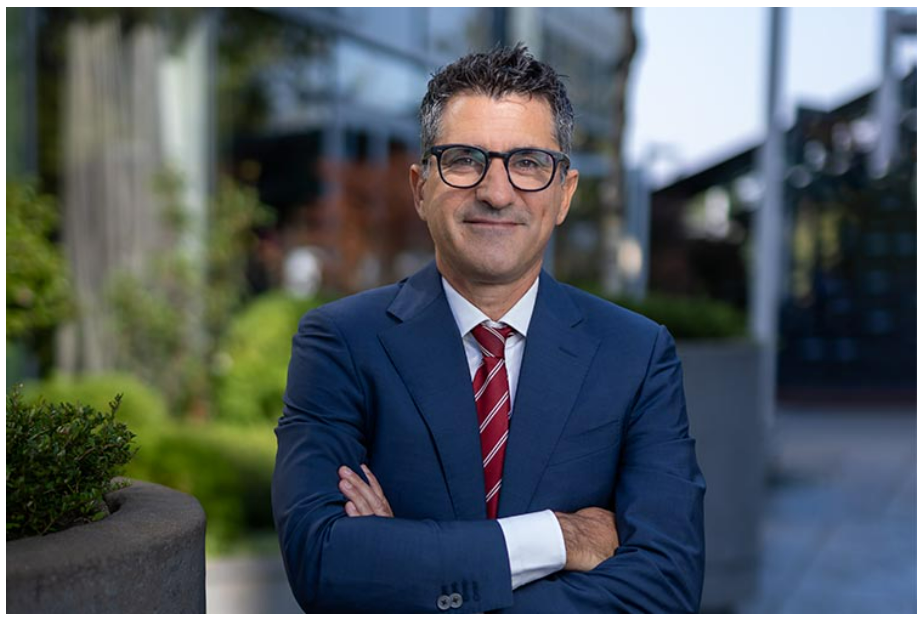 Serbia is no exception to this global trend. We are pleased with the support that we are providing to the Ministry of Mining and Energy for the country’s first renewable energy auction, which was recently conducted. We are confident that this will deliver cost-effective power to Serbian consumers, fostering investment and private sector participation, energy mix diversification and a subsequent reduced reliance on imported fossil fuels. And the ongoing auction is only the first round of a three-year plan that envisages the total allocation of 1,000 MW for wind power generation capacity and 300 MW for solar PV. We are fully committed to continue supporting this process, including by providing financing for investors that will be awarded capacities under the auctions, as well as to upgrade Serbia’s power transmission and distribution networks so that they can absorb the increased volume of intermittent solar and wind generation. The other key aspect of energy transition is reducing energy waste. We are going to significantly scale up our activities in this area, from direct financing of larger corporations to credit lines channelled through commercial banks for MSMEs, to accelerating the renovation of public and private buildings.
Serbia is no exception to this global trend. We are pleased with the support that we are providing to the Ministry of Mining and Energy for the country’s first renewable energy auction, which was recently conducted. We are confident that this will deliver cost-effective power to Serbian consumers, fostering investment and private sector participation, energy mix diversification and a subsequent reduced reliance on imported fossil fuels. And the ongoing auction is only the first round of a three-year plan that envisages the total allocation of 1,000 MW for wind power generation capacity and 300 MW for solar PV. We are fully committed to continue supporting this process, including by providing financing for investors that will be awarded capacities under the auctions, as well as to upgrade Serbia’s power transmission and distribution networks so that they can absorb the increased volume of intermittent solar and wind generation. The other key aspect of energy transition is reducing energy waste. We are going to significantly scale up our activities in this area, from direct financing of larger corporations to credit lines channelled through commercial banks for MSMEs, to accelerating the renovation of public and private buildings.
Where do your concerns lie and in what ways does the EBRD provide the most significant support to Serbia in continuing reforms in the sector of state-owned enterprises?
The improvement of corporate governance and the commercialisation of state-owned enterprises promotes and sustains market economies, but should also benefit state enterprises themselves, through improved competitiveness and greater efficiency. This, in turn, has benefits for society as a whole, through an improved level of the quality of public services and a reduced reliance on the state budget. All of this requires a clear definition of objectives for public enterprises by the state, as well as careful monitoring of whether and how those objectives are delivered, and this is where the greatest challenge lies.

We believe that Serbia took a courageous step with the adoption of the Strategy for State Ownership and the Management of Business Entities Owned by the Republic of Serbia for the period from 2021 to 2027, which the EBRD helped to develop and which sets the ambitious vision that inspired the new law on public enterprises. In addition, the EBRD is providing further support through corporate governance and corporate development activities linked to EBRD loans to Serbian public enterprises. For example, Srbija Voz [national passenger railway company] has already benefitted from a corporate governance improvement programme developed and implemented with EBRD assistance, while similar programmes are to be implemented for Serbia Cargo and Serbian Railways Infrastructure later this year. The EBRD is also supporting EPS [national electric utility power company] through a corporate development programme, which will include activities aimed at enhancing risk management, procurement and energy trading functions, among others. We also stand ready to assist the authorities in further defining governance standards through secondary regulation, all under the active role of the Ministry of Economy, which is supposed to become a central ownership entity that will coordinate with other ministries and agencies as and when needed.
Despite the delays in the EU accession process, significant progress has been made in establishing strong connections between the EU and Serbia in the transportation infrastructure domain. What would you emphasise as the most crucial steps that Serbia has taken with EBRD support?
Serbia is investing heavily in its road and rail network and I believe this has been a key enabler of the country’s success in attracting FDI in recent years. Beyond increasing connectivity with the EU and other countries of the Western Balkans, I believe these investments are also crucial for regional economic development and reducing the rationale for internal migration to the capital. When it comes to the EBRD, transport infrastructure is a core priority and represents a large share of our portfolio in Serbia.
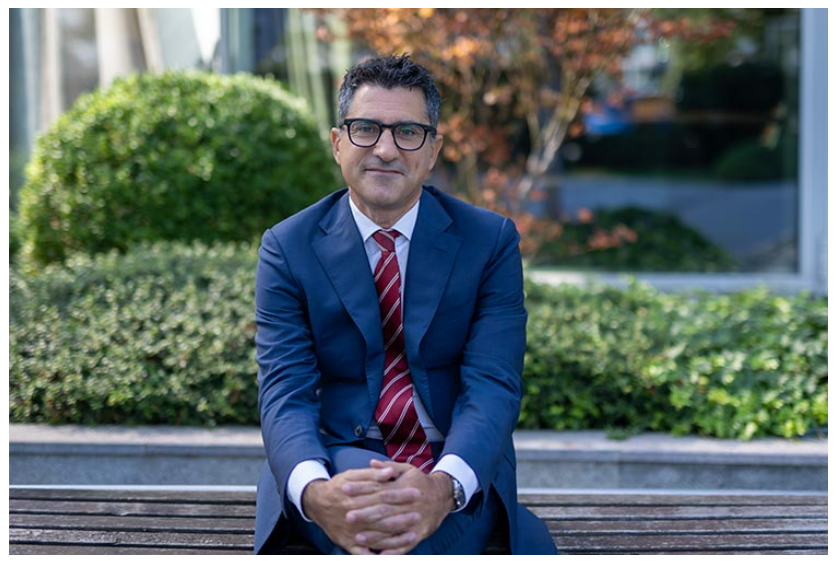
In the rail sector, we last year signed a €550 million financing programme for the modernisation and upgrade of the ca. 230 km-long electrified railway infrastructure section between Belgrade and Niš. This Project is a strategic priority for Serbia, as it forms part of the main rail transport corridor running through the country and is supported by the largest EU grant that the country has ever received. We, at the EBRD, are also committed to enabling public-private partnerships for the delivery of infrastructure, mobilising private capital and knowhow through competitive processes. We are pleased with the support that we provided for the Belgrade airport PPP, and we believe there are opportunities to do more, for example in the field of river ports.
Returning to the initial question that sparked our discussion, regarding economic growth, to what extent has Serbia made progress in building a knowledge-based economy? To what extent are investments in innovation infrastructure helping on the retention of talent and entrepreneurship in Serbia?
Serbia has progressed well in certain areas of the knowledge- based economy, increasing its exports of ICT services more than elevenfold between 2010 and 2022. Serbia’s ICT exports now exceed those of Estonia, which is one of the forerunners of digital services in Europe. This was helped by increasing global demand for digital services, relatively low labour costs and increasing interest in ICT education in the Western Balkans. However, the region’s wage competitiveness is decreasing rapidly and the future pool of experts may be constrained by demographic trends, especially as a higher share of those with more advanced digital skills are more likely to emigrate. Investments in education, research and business facilities are an important step in making the ICT boom sustainable.
That is why the EBRD is financing the expansion of existing science and technology parks, and the development of new ones, in Niš, Čačak and Kruševac, as well as the Bio4 campus in Belgrade. We believe this infrastructure will support the incubation and growth of innovative start-ups and businesses in Serbia. Equally important will be the rural broadband project, also EBRD financed, which will roll out high-speed internet to smaller communities across the country. Beyond infrastructure, we will also continue our SME advisory programme, supporting local enterprises to acquire the skills needed to succeed in the digital economy and integrate into international value chains.
